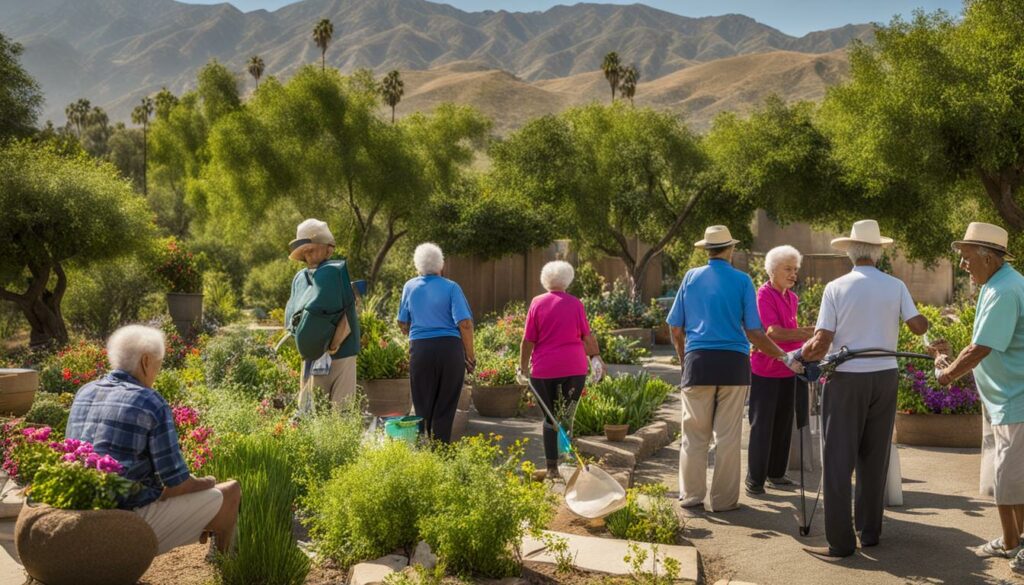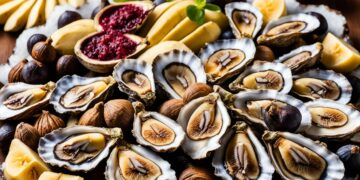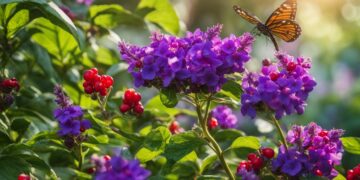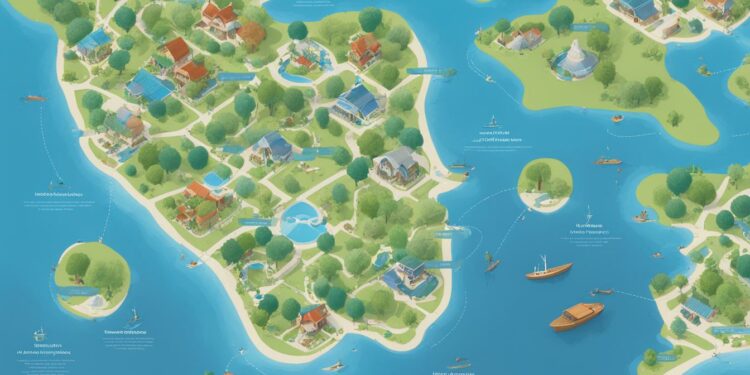Did you know that there are 5 regions in the world where people live significantly longer and healthier lives? These areas, known as the Blue Zones, have captured the attention of researchers and health enthusiasts around the globe.
Author Dan Buettner and the National Geographic Society identified these hotspots of longevity, where individuals often live beyond 100 years old, and enjoy a remarkable absence of health problems like heart disease, obesity, cancer, or diabetes.
In his book, “The Blue Zones Secrets for Living Longer: Lessons From the Healthiest Places on Earth,” Buettner explores the lifestyle habits and practices of these cultures, offering valuable insights and practical steps to incorporate them into our daily lives.
Key Takeaways:
- The Blue Zones are 5 regions in the world where people live longer and experience better health.
- These regions are characterized by a low prevalence of diseases like heart disease, obesity, cancer, and diabetes.
- Author Dan Buettner has extensively researched the lifestyle habits of these Blue Zone communities.
- The lessons from the Blue Zones can provide inspiration and guidance for healthy aging and longevity.
- By adopting key lifestyle habits such as a healthy diet and regular physical activity, we can increase our chances of living a long and fulfilling life.
The Mediterranean Blue Zone: Sardinia, Italy
Sardinia, Italy, located in the Mediterranean Sea, is renowned for its low rates of middle-age mortality and dementia. The longevity of the Sardinian population has been linked to their adherence to the traditional Mediterranean diet.
The traditional Mediterranean diet followed by the Sardinians is primarily plant-based, focusing on vegetables, fruits, whole grains, legumes, and healthy fats. This diet also includes smaller amounts of dairy products, such as goat’s milk and pecorino cheese, and lean sources of protein, such as fish and nuts.
The traditional Mediterranean diet is not only rich in essential nutrients but also features key components that contribute to longevity and overall health. It emphasizes whole, unprocessed foods and limits the consumption of refined carbohydrates, red meat, and processed foods.
A study published in the New England Journal of Medicine found that the traditional Mediterranean diet can significantly reduce the risk of major cardiovascular events, such as heart attacks and strokes.
Researchers have discovered that the traditional Mediterranean diet followed by the Sardinians is associated with a longer life span and lower rates of chronic diseases. It seems that the combination of fresh, locally sourced ingredients and nutrient-rich whole foods contributes to their health and well-being.
In addition to their diet, other factors in Sardinia contribute to the high prevalence of centenarians, such as an active lifestyle, strong community bonds, and a sense of purpose.
Sardinian Traditional Mediterranean Diet
The Sardinian traditional Mediterranean diet is characterized by:
- Abundant consumption of plant-based foods, including vegetables, fruits, legumes, and whole grains
- Regular consumption of healthy fats from olive oil, nuts, and seeds
- Limited intake of processed foods, red meat, and sugary beverages
- Modest consumption of dairy products, primarily goat’s milk and sheep’s milk cheese
- Focus on locally sourced and seasonal foods
The combination of these dietary habits, coupled with the Sardinians’ active lifestyle and strong community ties, contributes to their exceptional longevity and overall well-being.
| Dietary Factors | Benefits |
|---|---|
| Abundant plant-based foods | Provides essential vitamins, minerals, and antioxidants that support overall health and reduce the risk of chronic diseases |
| Healthy fats from olive oil, nuts, and seeds | Promote cardiovascular health, reduce inflammation, and support brain function |
| Limited intake of processed foods and red meat | Reduces the risk of obesity, heart disease, and certain types of cancer |
| Modest consumption of dairy products | Provides calcium and other essential nutrients without excessive saturated fat intake |
The Asian Blue Zone: Okinawa, Japan
Okinawa, Japan is renowned for being home to the world’s longest-lived women, with residents leading exceptionally long and healthy lives. One of the major factors contributing to their longevity is their unique and nutritious diet, known as the Okinawan blue zones diet.
This traditional diet of the Okinawan people revolves around the consumption of nutrient-rich foods that promote vitality and well-being. Remarkably, Okinawans have incorporated specific ingredients into their meals that have been directly linked to their extended lifespans.
“The residents of Okinawa attribute their longevity to their diet, which includes Okinawan sweet potatoes, soybeans, mugwort, turmeric, and bitter melon (goya).” -Dan Buettner
Key components of the Okinawan blue zones diet:
- Okinawan Sweet Potatoes: These purple-fleshed potatoes are rich in antioxidants, fiber, and slow-digesting carbohydrates, providing sustained energy throughout the day.
- Soybeans: A staple source of protein in the Okinawan diet, soybeans offer a multitude of health benefits, including reducing the risk of heart disease and supporting bone health.
- Mugwort: Known for its anti-inflammatory properties, mugwort is often included in traditional Okinawan dishes, contributing to overall well-being.
- Turmeric: This vibrant spice possesses strong anti-inflammatory and antioxidant properties, aiding in the prevention of chronic diseases and promoting longevity.
- Bitter Melon (Goya): A popular vegetable in Okinawan cuisine, bitter melon is believed to have blood sugar-regulating properties, contributing to a healthier metabolic state.
By embracing a diet rich in these nutritious ingredients, the people of Okinawa have reaped the benefits of enhanced longevity and prolonged health. The Okinawan blue zones diet serves as an inspiring example of how a conscious focus on wholesome, natural foods can contribute to a vibrant and fulfilling life.

The European Blue Zone: Ikaria, Greece
Ikaria, Greece, is a mountainous island in the Aegean Sea known for its remarkable population of centenarian men. With the highest concentration of men over 100 years old in the world, Ikaria has become a fascinating study in longevity.
One key factor contributing to the longevity of Ikarian men is their adherence to a unique dietary pattern, known as the blue zones diet. This low-protein diet has drawn attention from researchers and health enthusiasts alike.
Studies have shown that a low-protein diet, particularly one that is predominantly plant-based, can have numerous health benefits. It has been linked to lower rates of chronic diseases, such as diabetes and cancer, as well as a reduction in overall mortality for individuals under the age of 65.
The blue zones diet followed by the Ikarian men focuses on consuming primarily whole, unprocessed foods. Fresh fruits, vegetables, legumes, and whole grains form the foundation of their daily meals. Protein sources primarily come from plant-based options, such as beans and lentils, with limited intake of animal products.
This low-protein diet not only promotes healthy aging but also supports the overall well-being of the Ikarian population. By placing emphasis on nutrient-dense, natural foods, they are able to nourish their bodies and maintain vibrant health well into their advanced years.
Incorporating elements of the blue zones diet into our own lifestyles may hold the key to unlocking the secrets of longevity and optimal health. By adopting a plant-centric approach to our meals and reducing our reliance on processed and animal-based foods, we can align our eating habits with those of the centenarian men of Ikaria.
Key Features of the Blue Zones Diet in Ikaria:
- Emphasis on whole, unprocessed foods
- A variety of fresh fruits and vegetables
- Plant-based protein sources like beans and lentils
- Limited intake of animal products
- Incorporation of locally sourced ingredients
By incorporating these dietary principles into our own lives, we can strive for optimal health and longevity, just like the centenarian men of Ikaria.
Ikaria: A Land of Longevity
“The blue zones diet followed by the centenarian men of Ikaria offers valuable insights into the power of food choices in promoting longevity and overall well-being. By adopting a low-protein, plant-centric approach to our diets, we can learn from the wisdom of these remarkable individuals and pave the way for healthier futures.”
The Adventist Blue Zone: Loma Linda, California
Loma Linda, California, stands out as a remarkable community that boasts the highest concentration of Seventh-day Adventists in the United States. This community has captured the attention of researchers and health enthusiasts due to its extraordinary longevity and commitment to a lifestyle known as the “blue zones lifestyle.”
The blue zones lifestyle, inspired by the findings from the Blue Zones project conducted by Dan Buettner, emphasizes key principles to promote healthy aging and longevity.
One crucial aspect of this lifestyle is the adherence to a biblical diet, which forms the foundation of the Adventist community’s approach to nourishing their bodies and minds.

The biblical diet followed by the residents of Loma Linda primarily consists of grains, fruits, nuts, and vegetables. This plant-based approach to eating aligns with the core principles of their faith and is believed to contribute to their enhanced health and longevity.
By prioritizing wholesome, nutrient-rich foods, the Adventists in Loma Linda have unlocked the secret to healthy aging and longevity.
“Our biblical diet is designed to nourish our bodies and honor our connection to the divine. It is a powerful tool that enables us to lead fulfilling lives well into old age,” says Dr. David Kessler, a Seventh-day Adventist and renowned physician in Loma Linda.
A study published in the Journal of the American Medical Association found that following the biblical diet and adopting the blue zones lifestyle in Loma Linda may add an average of 10 more healthy years to residents’ lives compared to the average American population.
This significant increase in life expectancy highlights the remarkable impact of lifestyle choices on overall well-being.
The Power of Community
Beyond their dietary practices, the Adventist community in Loma Linda places a strong emphasis on connection and community. Social support and a sense of belonging are integral facets of their daily lives.
These strong bonds foster a supportive environment, encouraging healthy habits, and maintaining a positive outlook on life. The power of community plays a vital role in promoting healthy aging and overall well-being.
Embarking on a Blue Zones Journey
For those seeking to adopt a blue zones lifestyle, the Adventist community in Loma Linda serves as an inspiring example. By incorporating elements of the biblical diet and fostering strong social connections, individuals can embark on a path towards healthy aging and a meaningful life.
| Key Characteristics of the Adventist Blue Zone: Loma Linda, California |
|---|
| High concentration of Seventh-day Adventists |
| Biblical diet of grains, fruits, nuts, and vegetables |
| Community-oriented lifestyle focused on social connections |
| Longer average lifespan of approximately 10 years compared to the average American |
The Central American Blue Zone: Nicoya Peninsula, Costa Rica
The Nicoya Peninsula in Costa Rica is home to a remarkable Blue Zone, where residents enjoy exceptional health and longevity. This region boasts the world’s lowest rate of middle-age mortality and the second-highest concentration of male centenarians.
Researchers from the global Blue Zones Project have extensively studied the Nicoya Peninsula to uncover the secrets behind its exceptional health outcomes.
One key factor contributing to the remarkable longevity of Nicoya’s residents is the presence of strong faith communities. These communities provide a sense of belonging, social support, and a source of purpose and meaning in life. The power of faith and a deep spiritual connection has been shown to have positive effects on overall well-being and longevity.
In addition to strong faith communities, the Nicoya Peninsula’s culture emphasizes deep social networks.
Residents maintain close relationships with family, neighbors, and friends, which fosters a sense of connection and support. These strong social ties contribute to lower levels of stress, increased happiness, and improved health outcomes.
Another interesting aspect of the Nicoya Peninsula’s lifestyle is the prevalence of regular, low-intensity physical activity.
The residents engage in daily activities such as walking, gardening, and manual labor, which provide a natural form of exercise. This active lifestyle helps maintain cardiovascular health, muscle strength, and overall physical well-being.
By exploring and embracing the lifestyle factors that contribute to the exceptional health and longevity of the Nicoya Peninsula, we can learn valuable lessons on how to improve our own well-being and live longer, healthier lives.
Conclusion
The Blue Zones provide valuable insights into the secrets of longevity and healthy aging. Through years of research and the study of communities where people live exceptionally long lives, we have discovered that certain lifestyle habits are key to maintaining vibrant health as we age.
One of the most significant findings is the importance of adopting a plant-based diet. The residents of the Blue Zones prioritize the consumption of whole foods, like fruits, vegetables, whole grains, and legumes. This diet, rich in essential nutrients and antioxidants, has been linked to lower rates of chronic diseases and increased longevity.
In addition to a healthy diet, social connection plays a crucial role in healthy aging. The Blue Zones emphasize the benefits of staying socially engaged, nurturing meaningful relationships, and being part of strong and supportive communities.
Research has shown that individuals with robust social networks tend to experience better mental and physical health and increased longevity.
Finally, regular physical activity is key to maintaining a long and healthy life. The Blue Zones highlight the importance of incorporating movement into our daily routines, whether through gardening, walking, or engaging in traditional activities.
Regular exercise not only promotes physical fitness but also supports cognitive function and overall well-being, contributing to healthy aging.
FAQ
What are the Blue Zones?
The Blue Zones are regions where people live the longest and healthiest lives. These areas are identified by a high concentration of individuals who live to be over 100 years old and have low rates of diseases like heart disease, obesity, cancer, and diabetes.
Who identified the Blue Zones?
The Blue Zones were identified by author Dan Buettner and the National Geographic Society.
What is the Blue Zones lifestyle?
The Blue Zones lifestyle refers to the habits and practices followed by people living in these longevity hotspots. It involves adopting certain diet and lifestyle habits to promote healthy aging and long life.
What is the Blue Zones diet?
The Blue Zones diet is the traditional dietary pattern followed by the inhabitants of the Blue Zones regions. It typically includes a high consumption of plant-based foods such as vegetables, fruits, whole grains, legumes, and nuts, while limiting the intake of processed foods, sugar, and unhealthy fats.
What are the secrets to longevity in the Blue Zones?
The secrets to longevity in the Blue Zones include following a predominantly plant-based diet, engaging in regular physical activity, maintaining strong social connections, finding purpose in life, and having a supportive community.
Where are the Blue Zones located?
The Blue Zones are located in different parts of the world, including Sardinia, Italy; Okinawa, Japan; Ikaria, Greece; Loma Linda, California; and the Nicoya Peninsula in Costa Rica.
What research has been done on the Blue Zones?
The Blue Zones have been extensively researched by experts to understand the factors contributing to the long and healthy lives of the people living in these regions. Various studies have examined their diet, lifestyle habits, social dynamics, and environmental factors.
How can I incorporate Blue Zones lifestyle habits into my life?
You can incorporate Blue Zones lifestyle habits into your life by adopting a plant-based diet, engaging in regular physical activity, nurturing social connections, finding a sense of purpose, and creating a supportive community around you.
Can the Blue Zones lifestyle help with healthy aging?
Yes, adopting the Blue Zones lifestyle can contribute to healthy aging by promoting overall well-being, reducing the risk of chronic diseases, and enhancing longevity.



























